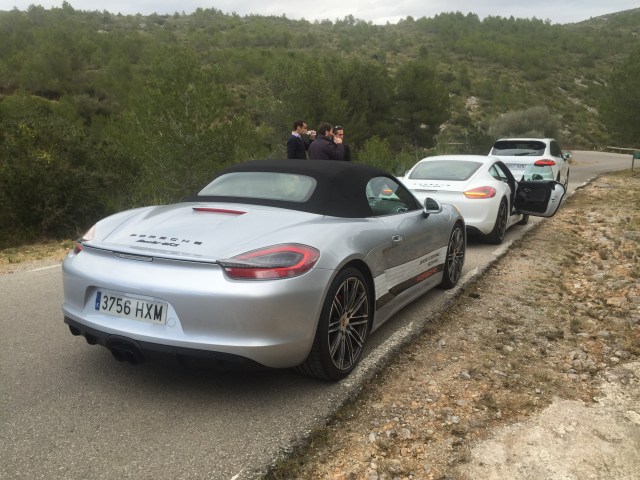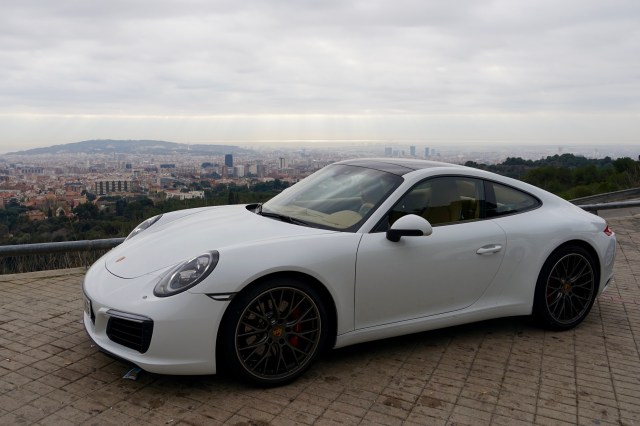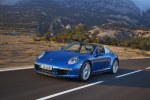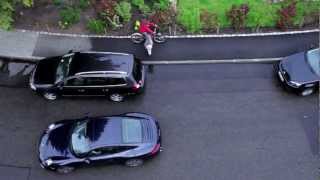Stockholm i Januari, temperaturen är ett par grader över noll. Ett tätt molntäcke hänger som en mörk slöja över staden och gör dagen om möjligt mörkare. Asfalten är blöt och fukten omsluter allting. Men det kunde vara värre; framför mig står en ny Porsche 911 Carrera S (991). Lämpligt nog är bilen mörkgrå för att matcha dagens ljusförhållanden.
Låt oss börja med utseendet – 991:an är riktigt snygg. Tack vare att den är längre, och framförallt, har längre hjulbas än föregångaren (997), så är den väsentligt mer välproportionerlig, samtidigt som den behåller 911:ans klassiska formspråk.

Sätter mig i bilen. Första intrycket är positivt. Inredningen som har tagit stort intryck av Panameran är inbjudande och den höga mittkonsolen gör att det känns som att man sitter nedsänkt i bilen.
Kör försiktigt iväg med bilen i Normal-läget. Komforten är mycket bra. Kan en så här komfortabel bil verkligen vara seriöst sportig?
Efter en stund slår jag över till Sport-läget. Nu vaknar bilen till liv. Klyschan om Dr. Jekyll och Mr. Hyde har aldrig stämt så väl som på denna bil.
I snabba kurvor är 991:an mycket stabil. Bilen är utrustad med Porsches aktiva krängningshämmare (PDCC), som gör att bilen inte kränger i kurvorna. I snabba doserade kurvor känns det nästan som att bilen lutar inåt. Stabiliteten är brutal, inte minst tack vare den bredare spårvidden fram jämfört med 997:an. Trots att bilen är bakhjulsdriven har jag svårt att komma på en bil som skulle vara mer effektiv denna regniga dag.
Den elektriska servostyrningen imponerar. På gott och ont är den är inte lika direktstyrd som i min Ferrari California, men framför allt känns styrningen inte artificiell. Ni kan vara lugna, vägkänslan finns kvar.
Bilen är utrustad med Sport Chrono, vilket innebär att jag har ett Sport Plus-läge att tillgå. Skillnaden mot Sport-läget är inte jättestor. Även i Sport Plus-läget är växlingarna i PDK-lådan effektivt sömlösa. I föregångaren fick man en liten spark i ryggen vid varje uppväxling; det var sportigt, men inte lika effektivt. PDK-lådan är uppdaterad jämfört med 997 och skillnaden märks. Växlingarna är minst lika snabba, men om möjligt än mer sömlösa. Växellådan tvekar heller inte vid krypkörning i låga hastigheter. I och med uppdatering är PDK-lådan minst lika bra som dubbelkopplingslådan i min Ferrari California.
Motorljudet är mycket bättre i 991 jämfört med gamla 997. Insugs- och motorljud är väldigt mustiga och klingar fint. Detta uppnås delvis genom att leda in ljud från insuget i coupén, men vad gör det när det låter så här fint. Bilen jag kör har sportavgassystem. Efter en del mixtrande med sportavgassystemet kommer jag fram till att det är bättre att ha det avstängt. Sportavgassystemet tillför, logiskt nog, avgasljud och det överröstar det fina insugs- och motorljudet. Det blir lite för mycket bröl, helt enkelt.
Om jag jämför med min gamla 997 GT3 (mk1) så är en 991 Carrera S minst lika snabb, men samtidigt mycket lättare att leva med till vardags. Om man inte ser obekvämlighet som ett plus så finns det ingen anledning att blicka tillbaka.
Porsche 991 Carrera S är den mest perfekta sportbil som går att köpa idag. Men är den för perfekt? Saknar den karaktär och passion? Kritik har framförts i denna riktning, men jag håller inte med. Efter att ha tagit en snabb kurvkombination, ackompanjerad av det vackra ljudet, kunde jag inte låta bli att först le och sedan skratta av välbehag. Bättre betyg går inte att ge till en bil.






























